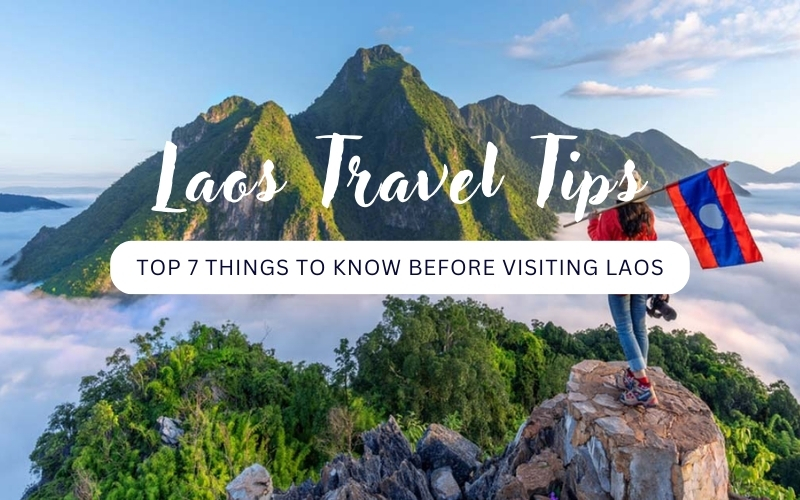
Laos, known as the “Land of a Million Elephants”, is a peaceful and culturally rich destination located in the heart of Southeast Asia. With lush landscapes, ancient temples and warm hospitality, Laos offers a unique travel experience that combines natural beauty with deep cultural traditions. Read this article on what to know before visiting Laos to ensure a smooth and memorable experience in this wonderful country.
Laos weather and best time to visit
Laos has a tropical monsoon climate, divided into two distinct seasons: the dry season and the rainy season. Therefore, the ideal time to visit Laos depends on the time and preferences of the traveler. The dry season from November to April is often considered the best time for tourists. During this time, the weather is quite pleasant and dry, with average temperatures ranging from 20–30°C (68–86°F), nighttime temperatures in some northern mountainous areas even dropping below 10°C (50°F).
The dry season is perfect for outdoor activities such as visiting temples, walking around beautiful towns like Vientiane and Luang Prabang, or cruising along the Mekong River. Although April is the hottest month, it is an ideal time to visit the highlands, and also a festive time when the country celebrates Pi Mai Lao (Lao New Year), with water fights and cultural events adding a vibrant energy to the heat.
The rainy season from May to October brings short showers, often in the afternoon. The rains transform the countryside into lush, green landscapes, making it a great time for nature lovers. In addition, there are fewer tourists at this time of year, offering a more tranquil and private experience, and other services such as accommodation, restaurants and flights are often discounted. However, visitors should be prepared for higher humidity and the possibility of trip disruption due to flooding or poor road conditions in rural areas.

best time to visit Laos
How to get to Laos
Traveling to Laos
There are several ways to get to Laos, by air, land or water, depending on your departure point and preferences. The most convenient way is by air, with international airports in Vientiane, Luang Prabang and Pakse connecting Laos to major cities around the world and the region. If you are departing from neighboring countries such as Thailand, Vietnam, Cambodia or China, direct international buses are the most popular and cost-effective choice. For a more adventurous route, visitors can enter Laos by water, particularly along the Mekong River.
Traveling around Laos
- By air: For faster travel, there are domestic flights between major cities including Vientiane, Luang Prabang and Pakse. Airlines such as Lao Airlines and Lao Skyway operate these routes, making them ideal for covering long distances within hours.
- By bus: This is the most popular and economical way to travel between cities and regions in Laos. However, they are often slow as they usually stop to pick up passengers along the way and are often delayed, so you may want to bring snacks and water for the trip.
- By private car or taxi: This is ideal for long distances or to travel on your own schedule. Negotiate the price carefully before getting in a taxi to avoid being ripped off and choose a reputable company to rent a car for a long trip.
- By Tuk-Tuk and Songthaew: Tuk-Tuk (motorized rickshaw) and Songthaew (shared pickup truck with bench) are popular for short distances and local travel, suitable for large groups.
- By motorbike or bicycle: For a more adventurous experience, you can rent a motorbike or bicycle to explore Laos at your own pace. Always wear a helmet, carry an international driving license, and check the condition of the vehicle before renting to ensure safety.

Lao Airlines
Visa and entry requirements
Traveling to Laos is made easy with a variety of visa options to suit different nationalities and travel needs. Visitors can take advantage of the Visa on Arrival (VOA), available at major entry points such as Wattay International Airport in Vientiane, Luang Prabang International Airport, and the Friendship Bridge (Nong Khai–Vientiane). The VOA allows stays of 30 days and requires a passport valid for at least six months and a visa fee (approximately US$40, depending on nationality). Moreover, the eVisa system offers an online application option for visitors from over 180 countries. This eVisa, also valid for 30 days, can be issued within three working days.
Visitors from ASEAN countries can apply visa-free for short-term stays ranging from 14 to 30 days. For longer stays or specific purposes, such as business, you can apply for a visa in advance at a Lao embassy or consulate. However, if you overstay, you will be charged a daily fine of approximately US$10. To ensure a smooth trip, always check the latest visa requirements and entry policies via the official Laos eVisa website before traveling.
Embark on an unforgettable journey with Laos tours, where breathtaking landscapes, rich cultural heritage, and warm hospitality await at every turn.

Lao passport
Currency and payments in Laos
The official currency of Laos is the Lao Kip (LAK), which is used for most domestic transactions. However, US dollars and Thai baht are also widely accepted in tourist areas, hotels and border areas, and you will receive your change in Kip. Tourists can exchange money at banks, hotels, airports or ATMs for a small fee. Other payment methods such as Visa cards, bank transfers are accepted at restaurants, upscale hotels or shopping malls in major cities, so it is advisable to bring cash to avoid problems when paying. To ensure a smooth experience, exchange money in cities before going to remote areas, carry smaller bills for daily use and always be wary of counterfeit notes.
Local customs and cultural etiquette
Unique national symbols
Laos is known as the “Land of a Million Elephants” because of the image of elephants appearing on the national emblem and many legends. Elephants play an important role in Lao history and culture, symbolizing strength, prosperity and luck. Visitors can participate in elephant riding, elephant bathing or elephant performances to experience this unique culture.

Elephant is the national symbol of Laos
Laos religion
Buddhism is the main religion of Laos, playing an important role in the spiritual life of the people. The influence of Buddhism is clearly shown in the architecture and art with ancient temples throughout the country. When visiting temples, do not touch Buddha statues or take photos without permission. Wear polite clothes that cover your shoulders and knees, and remember to take off your shoes before entering. Monks hold a highly respected position in Lao society. Women should avoid direct contact with monks or handing them objects directly, instead use a cloth or place the object within their reach.

Pha That Luang, the most famous temple in the country
Lao communication culture
Learn simple phrases like “Sabaidee” (hello) or “Khawp Jai” (thank you) to get more exposure to the locals. Smile to keep the atmosphere friendly. While shaking hands is more common in other regions, Lao people use the gesture of clasping hands towards the other person and bowing slightly, called “nop”. The degree of bowing shows the level of respect for the other person. In Lao culture, greetings that involve physical contact such as hugging or kissing are to be avoided, especially on the head, as this is considered disrespectful.

Laos greeting custom, nop
Main attractions to visit in Laos
Vientiane
Unlike other places, the capital of Laos, Vientiane, is not too noisy and bustling, bringing a strange peace to tourists. With a long and prominent history, Vientiane stands out with ancient architectural works, bearing the mark of Buddhism through Buddha statues and elaborately carved reliefs. Some of the iconic landmarks of this beautiful capital are Pha That Luang, the victory monument Patuxay and Wat Phra Keo.
Discover the spiritual heart of Laos with our guide to the top 11 most famous Buddhist temples, where history, culture, and serenity come together in breathtaking harmony.

the victory monument Patuxay
Luang Prabang
Luang Prabang is the most popular tourist destination and a UNESCO World Heritage Site. The appeal of Luang Prabang comes not only from its historical and cultural heritage but also from its quiet and peaceful beauty. The ancient streets, the pretty little houses with classic French architecture, all create a beautiful and romantic picture. Climb Mount Phousi for a panoramic view of the city or explore Kuang Si Waterfall and Pak Ou Caves with thousands of Buddha statues. Visitors can also witness or participate in the daily morning alms-giving ceremony, a sacred tradition where monks collect offerings from locals and tourists.

Kuang Si waterfalls
Vang Vieng
With an ideal terrain, peaceful scenery and fresh, cool climate, Vang Vieng attracts a large number of tourists every year. Coming to Vang Vieng, visitors must try the experience of rowing on the Nam Song River or try climbing Pha Hon Kham cliff to admire the beautiful sunrise or sunset. Visitors can also explore Tham Pha Daeng cave, a cave containing an underground river as well as a habitat for hundreds of bats. Vang Vieng is the ideal place for those who love nature and tranquility.

Vang Vieng Lagoons
Si Phan Don (4,000 Islands)
Si Phan Don is a land of up to 4,000 large and small islands of different shapes and sizes on the Mekong River in Laos. The “Land of 4,000 Islands” also includes Khone Phapheng – the largest waterfall in Southeast Asia. Under Khone Falls, there is a population of Irrawaddy dolphins (freshwater dolphins) of about 50 and is in danger of extinction.

Impressive Views of Si Phan Don
Tham Khoun Xe
Tham Khoun Xe, also known as Xe Bang Fai River Cave, is a remarkable natural wonder located in the remote Khammouane Province of central Laos. It is the world’s largest river cave with massive caverns up to 120m high and many impressive geological formations. Besides admiring the beauty of the cave, visitors can explore the wildlife in the Hin Nam Nor National Protected Area or kayak to explore the cave.

Tham Khoun Xe
Must-try dishes in Laos
Laap
Laap is considered a lucky dish in Laos, often served during festivals and celebrations. This is a grilled meat salad made from beef, pork or chicken, combined with raw vegetables and spices.

Laap, a lucky dish in Laos
Tam Mak Hoong
Tam Mak Hoong is a traditional Lao salad made from thinly sliced green papaya mixed with garlic, chili, peanuts, and Lao fish sauce. This dish is similar to Thai papaya salad, the only difference is that it does not have peanuts and the fish sauce used is fermented fish sauce. This dish has a characteristic sour and spicy taste and is often served with white rice.
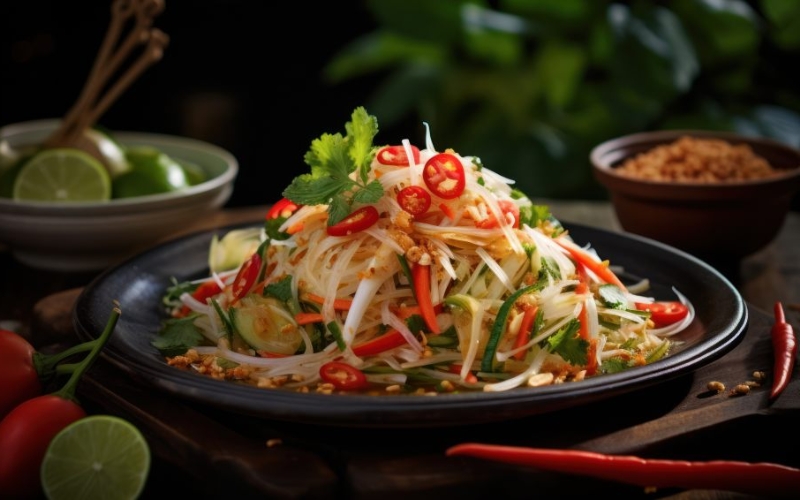
Tam Mak Hoong
Mok Pa
This is a traditional Lao dish, known for its unique preparation and rich flavor. Mok Pa involves wrapping fish (usually carp or catfish) with spices such as garlic, chili, mac khen (a typical spice of Lao cuisine) and kaffir lime leaves in banana leaves, then steaming it over charcoal. When enjoying, you will feel the aroma of the fish combined with the spicy taste of chili and mac khen, creating an impressive and rich culinary experience of Laos.

Mok Pa
Khao Soi
Khao Soi is a traditional Lao dish made with chewy noodles and chicken or beef, cooked in a delicious broth made from carrots, potatoes and coconut milk. This dish has the natural sweetness of the vegetables and the rich flavor of the meat, creating a unique and attractive flavor.
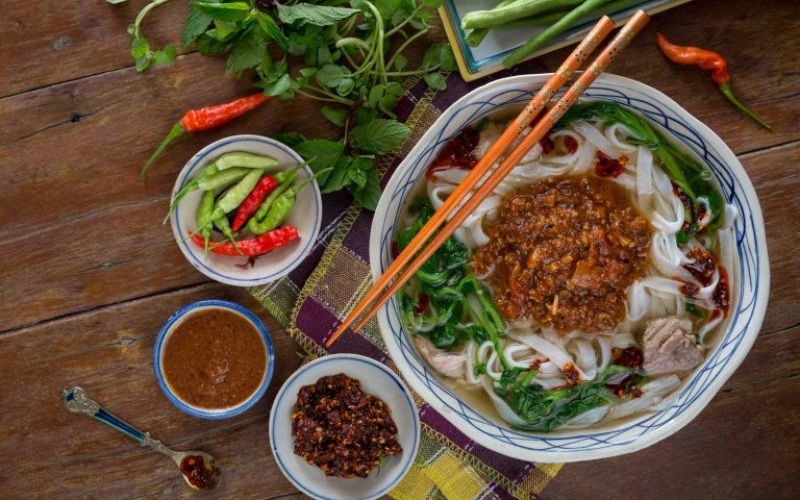
Khao Soi
Sai Oua
Sai Oua is a Lao sausage made from minced pork marinated with herbs and steamed with galangal, kaffir leaves, shallots, coriander, chili and fish sauce. It has a rich, aromatic flavor and is usually grilled over charcoal until golden brown. This dish is popular with many Lao people and tourists because it is easy to eat and goes well with many dishes.
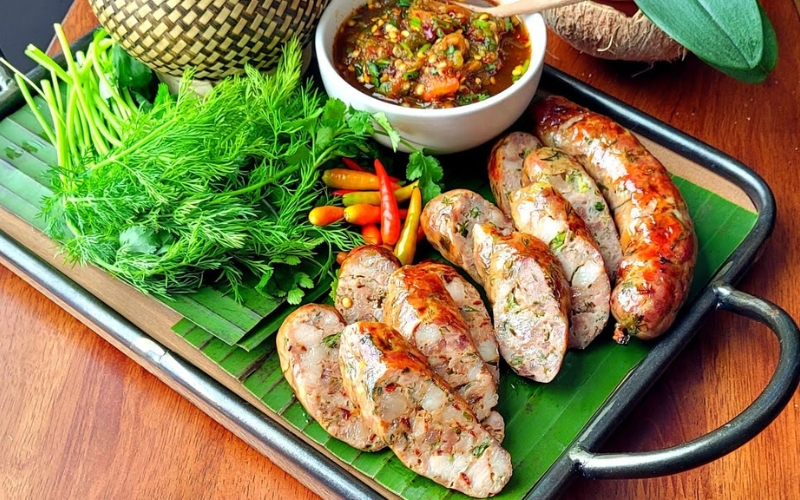
Sai Oua, Laos sausage
Insects
In Lao cuisine, insects are considered an indispensable part. Dishes made from insects are considered delicious and nutritious. Dishes made from insects are not only considered a rich source of nutrition but also a part of daily meals and festivals. This is considered part of the diversity and creativity in Lao cuisine and is also a unique point that attracts the attention of tourists when coming to this country.

grilled insects in Laos
Laos is a beautiful and peaceful country that offers visitors a unique blend of culture, history, and natural beauty. By keeping a few key things in mind—like respecting local customs, understanding basic travel tips, and embracing a laid-back pace of life—you’ll be better prepared to enjoy everything this amazing destination has to offer.
Read more:




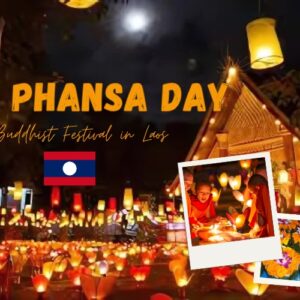
One of the things I appreciated about Laos is how straightforward the visa process is. Many nationalities can get a visa on arrival at major airports and land borders. Just remember to bring a passport-sized photo and cash to pay the fee. It’s always a good idea to double-check the latest requirements before you travel.
Dear Alice,
Thank you for sharing your experience! We completely agree that the visa on arrival process in Laos is straightforward and traveler-friendly. We always recommend our clients bring a passport-sized photo and cash in USD for the visa fee, as you mentioned. Additionally, we advise double-checking the visa requirements for your nationality closer to your travel date to ensure a smooth experience. If you need assistance with the latest visa updates or have any questions about your trip to Laos, feel free to contact us—we’re here to help! Safe travels!
Best regards,
IDC Travel Team